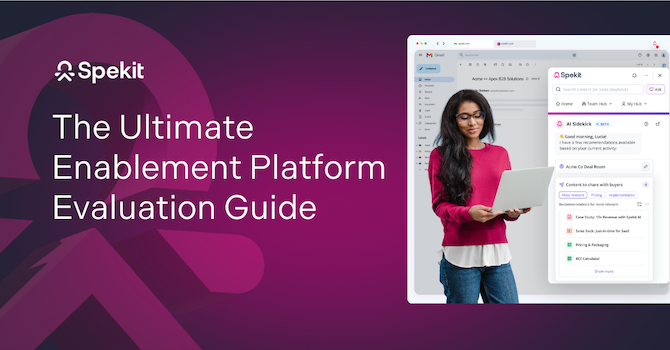ŌĆ£AI wonŌĆÖt fix your content chaos. But it can amplify whatŌĆÖs working, if you start with a better system.ŌĆØ - Seth McGuire, COO, ║┌┴Ž│į╣Ž═°
If youŌĆÖve ever launched a product and felt like it disappeared into a black hole after launch dayŌĆ” youŌĆÖre not alone.
And if youŌĆÖve ever heard a rep pitch a brand-new feature using six-month-old messaging? YouŌĆÖre in good company.
In todayŌĆÖs ŌĆ£change economy,ŌĆØ product innovation is moving faster than ever. But most go-to-market (GTM) motions still act like weŌĆÖre shipping once a quarter.
The result? Content chaos. Missed revenue opportunities. And product launches that fall flat, not because of bad product launch strategy, but because of broken execution.
In a recent webinar, our COO Seth McGuire, Sr. Product Marketing Manager Jeanna Roggow, and Head of Customer Strategy David Lott unpacked what needs to change and how teams are using AI to fix it.
This recap gives you the full playbook but you can watch the full recording below as well.
The new reality: Product innovation outpaces GTM systems
ŌĆ£YouŌĆÖre not imagining it, there are more launches, more updates, more change. But your content systems arenŌĆÖt built for speed.ŌĆØ ŌĆö Seth McGuire
LetŌĆÖs start with the elephant in the room: the pace of change.
According to (a cool 340 slides), weŌĆÖre living through an era of exponential product innovation. Features ship weekly. Launches are constant. Reps are bombarded with updates.
But while the pace of product is speeding up, the systems meant to support sales havenŌĆÖt evolved.
Old playbooks (static sales decks, launch enablement emails, once-a-month training sessions) just canŌĆÖt keep up.
And itŌĆÖs not just a hunch. Consider these numbers from our own research conducted recently with the Sales Enablement Collective (you can snag the full report here):
- 92.3% of enablement leaders say reps use less than 60% of their content
- 40% of a repŌĆÖs time is spent searching for or recreating content
- 50% of teams say more than 40% of their content needs a refresh
Bottom line? WeŌĆÖre overwhelming our reps, underdelivering at launch, and missing the moment to drive revenue.
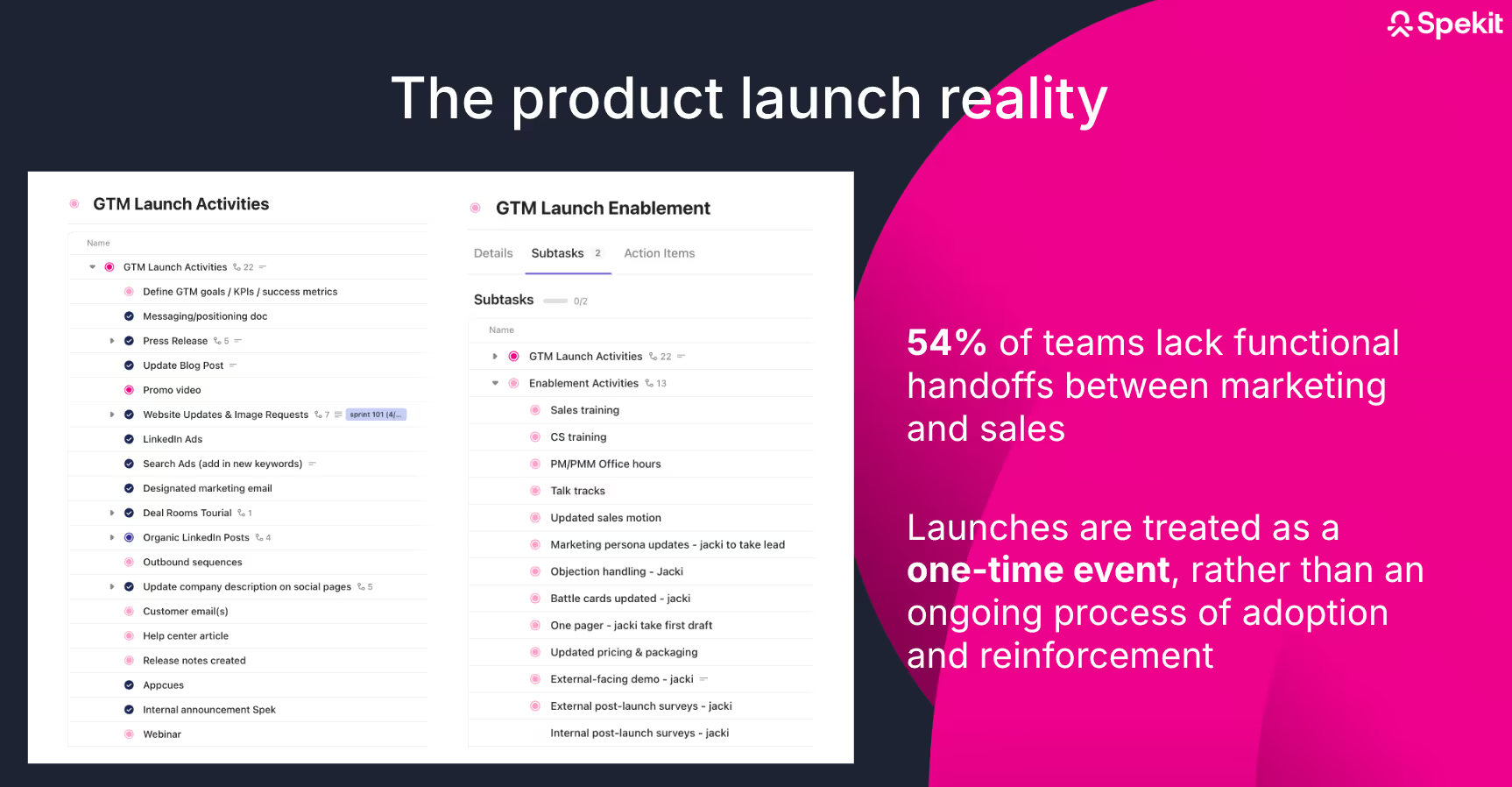
WhatŌĆÖs broken: The content-to-revenue disconnect
Seth broke it down in six clear friction points, three on the creation side, three on discovery:
1) Broken content creation
- Every launch starts from scratch
PMMs feel like theyŌĆÖre rebuilding the wheel every time with new decks, docs, one-pagers, training. - Content lives in too many formats
A single launch can require assets in Google Docs, SharePoint, PDF, Slack, LMS, emailŌĆ” itŌĆÖs overwhelming. - ThereŌĆÖs no central view of whatŌĆÖs live or accurate
If youŌĆÖve ever found five versions of the same deck in five places, you know the pain.
2) Broken content discovery
- Reps are overwhelmed by comms
Launches get announced in email, Slack, the LMS, the wiki. Which oneŌĆÖs right? Who knows? - Content is fragmented across systems
Most reps check 3+ repositories to find anything useful. - You canŌĆÖt see whatŌĆÖs working
Is that slick one-pager being shared? Did that case study land? With no insight, itŌĆÖs all guesswork.
The result? Missed quotas, inconsistent messaging, and product launches that donŌĆÖt stick.
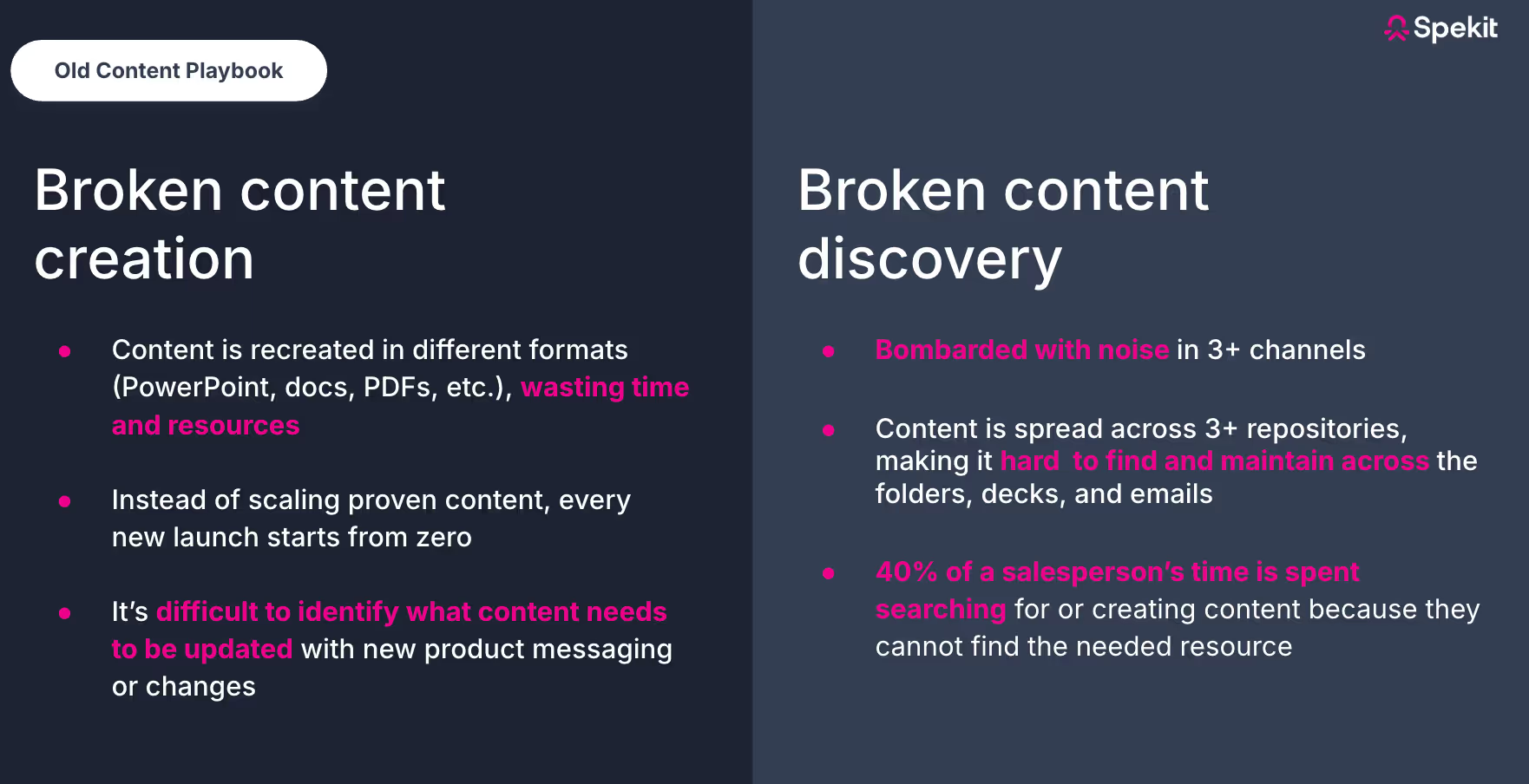
The turning point: Why AI Is only part of the solution
ŌĆ£AI is powerful but it canŌĆÖt save a broken process.ŌĆØ - Jeanna Roggow
AI is everywhere. 81% of sales teams are using it, and those that do are seeing faster growth.
But hereŌĆÖs the uncomfortable truth: AI canŌĆÖt help if your foundation is fragmented.
More content isnŌĆÖt the answer. Better connected content is.
To make AI work, you need:
- Structured content (tagged, labeled, versioned)
- Unified access (no more content scavenger hunts)
- Contextual delivery (relevant to the buyer, moment, and workflow)
AI is an amplifier. It doesnŌĆÖt automatically clean the house, it shines a light on the mess.
What does work: 3 friction points you can actually solve with AI
Gina laid out a tactical roadmap, pulling from her experience as both a PMM and a former startup marketer:
1. Content must be unified and measurable
ŌĆ£Unified doesnŌĆÖt mean ŌĆśdump it all in a folder.ŌĆÖ It means structured, trackable, and flexible.ŌĆØ - Jeanna Roggow
With ║┌┴Ž│į╣Ž═°, companies create modular, centralized content systems that:
- Let one asset live in multiple places (onboarding, deal rooms, battlecards)
- Automatically surface based on role, industry, or stage
- Tie back to usage data and revenue insights
This is the opposite of ŌĆ£build and hope.ŌĆØ ItŌĆÖs ŌĆ£build once, measure always.ŌĆØ
2. Content must be delivered in the right moment
ŌĆ£Just-in-time delivery isnŌĆÖt a nice-to-have, itŌĆÖs table stakes.ŌĆØ
- Jeanna Roggow
Even great content fails when it shows up late. AI Sidekick solves that by:
- Reading the screen, CRM, or email thread
- Surfacing the right case study, asset, or email template
- Delivering it in the moment of need (in Gmail, Salesforce, Outreach, and more)
This isnŌĆÖt just time-saving, itŌĆÖs trust-building. Your reps stop guessing. Your buyers feel heard.
3. Impact must be measurable and visible
ŌĆ£You canŌĆÖt optimize what you canŌĆÖt see.ŌĆØ - Seth McGuire
║┌┴Ž│į╣Ž═°ŌĆÖs analytics engine closes the loop with:
- Real-time tracking: see whatŌĆÖs viewed, shared, clicked
- Deal room engagement: which assets move the needle
- Revenue attribution: tie content to closed-won deals
Seth even shared how he filters by launch date to check if reps are using new case studies post-release. ŌĆ£ItŌĆÖs how I hold my team accountable,ŌĆØ he said.
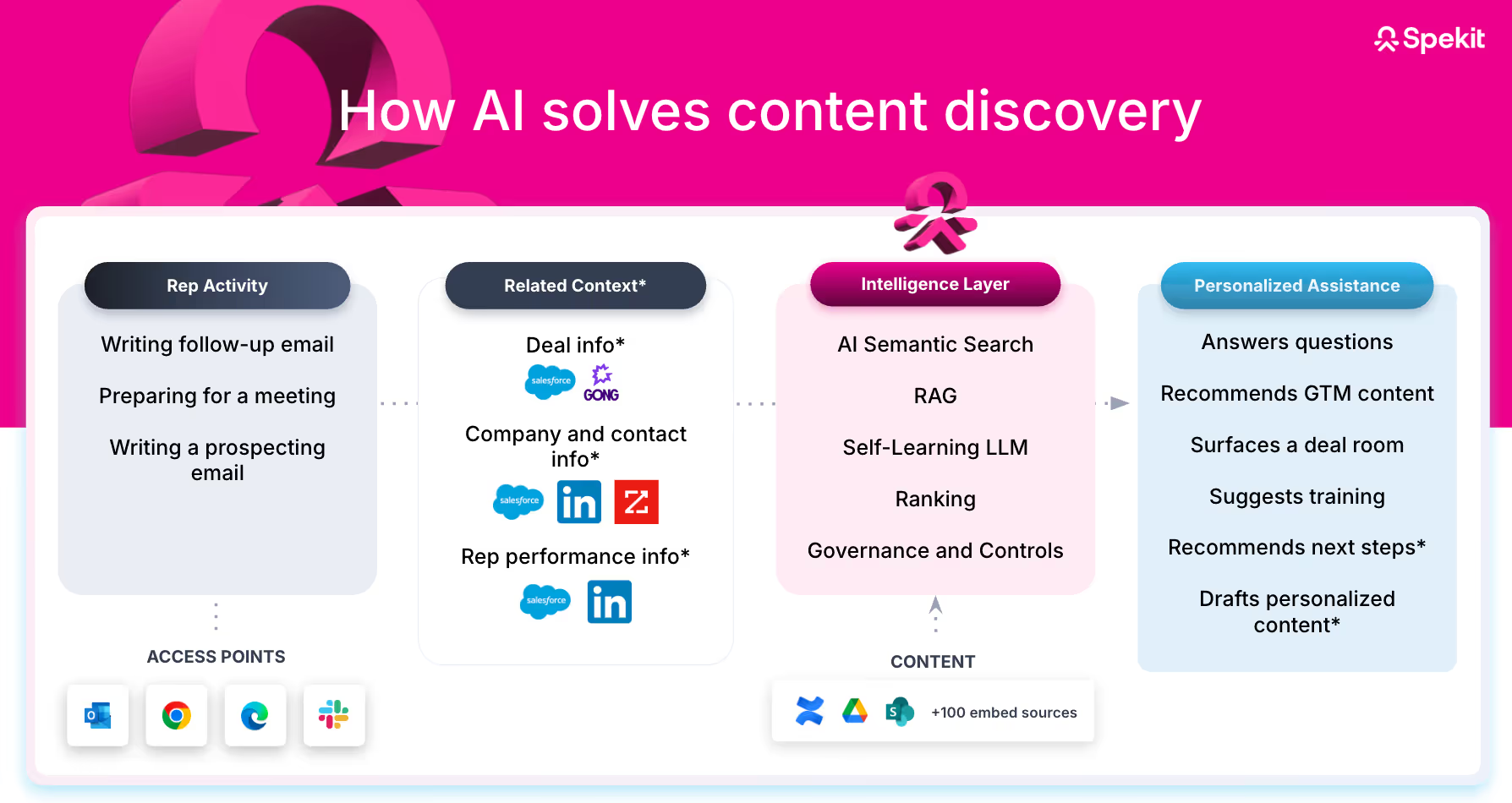
Customer story: What it looks like in the wild
David walked through a real-world product launch from a major tech company using ║┌┴Ž│į╣Ž═°:
1) They started with a Playlist
One central hub for reps with:
- FAQs
- Product overviews
- Pricing updates
- Messaging and positioning
- Buyer-ready collateral
2) AI Sidekick handled delivery
When a rep emailed a CRO about a new product, Sidekick popped up:
- Talking points tailored to the CRO
- Suggested case studies
- Internal training docs
- External links to add to a deal room
3) They tracked everything
- What got shared
- Who viewed it
- What content moved deals forward
- Which personas were most engaged
It wasnŌĆÖt magic. It was structured content, surfaced in context, tied to outcomes.
Internal best practices: How we do it at ║┌┴Ž│į╣Ž═°
ŌĆ£Our CEO caught me asking questions I shouldŌĆÖve checked in ║┌┴Ž│į╣Ž═°. ThatŌĆÖs how embedded it needs to be within the culture.ŌĆØ - Seth McGuire
At ║┌┴Ž│į╣Ž═°, we practice what we preach. Every launch is supported with:
- Spotlights: In-app announcements linked to fresh specs
- Playlists: Role-specific content journeys for onboarding and training
- AI Sidekick: Embedded across our apps to answer questions and surface help
- Trackable Links: Used in live selling to see what lands
- Revenue Insights: Monitored weekly to spot whatŌĆÖs driving real impact
ItŌĆÖs how weŌĆÖve made ŌĆ£just-in-timeŌĆØ not just a theory but our operating system.
The bigger vision: Just-in-time enablement, realized
If youŌĆÖve read Chapter 5 of Melanie FellayŌĆÖs book, youŌĆÖll recognize the threads running through this entire conversation.
This webinar wasnŌĆÖt just a product demo, it was the application of that vision:
- Personalized, contextual, in-the-flow content
- AI-powered, but human-relevant
- Structured systems that scale and adapt
HereŌĆÖs how Melanie puts it:
ŌĆ£Imagine your repŌĆÖs super-smart buddyŌĆöan AI assistantŌĆöwhispers, ŌĆśUse this case study instead.ŌĆÖ ThatŌĆÖs the future. Not more noise. But the right whisper, at the right │┘Š▒│Š▒.ŌĆØ
ThatŌĆÖs what ║┌┴Ž│į╣Ž═° is building.
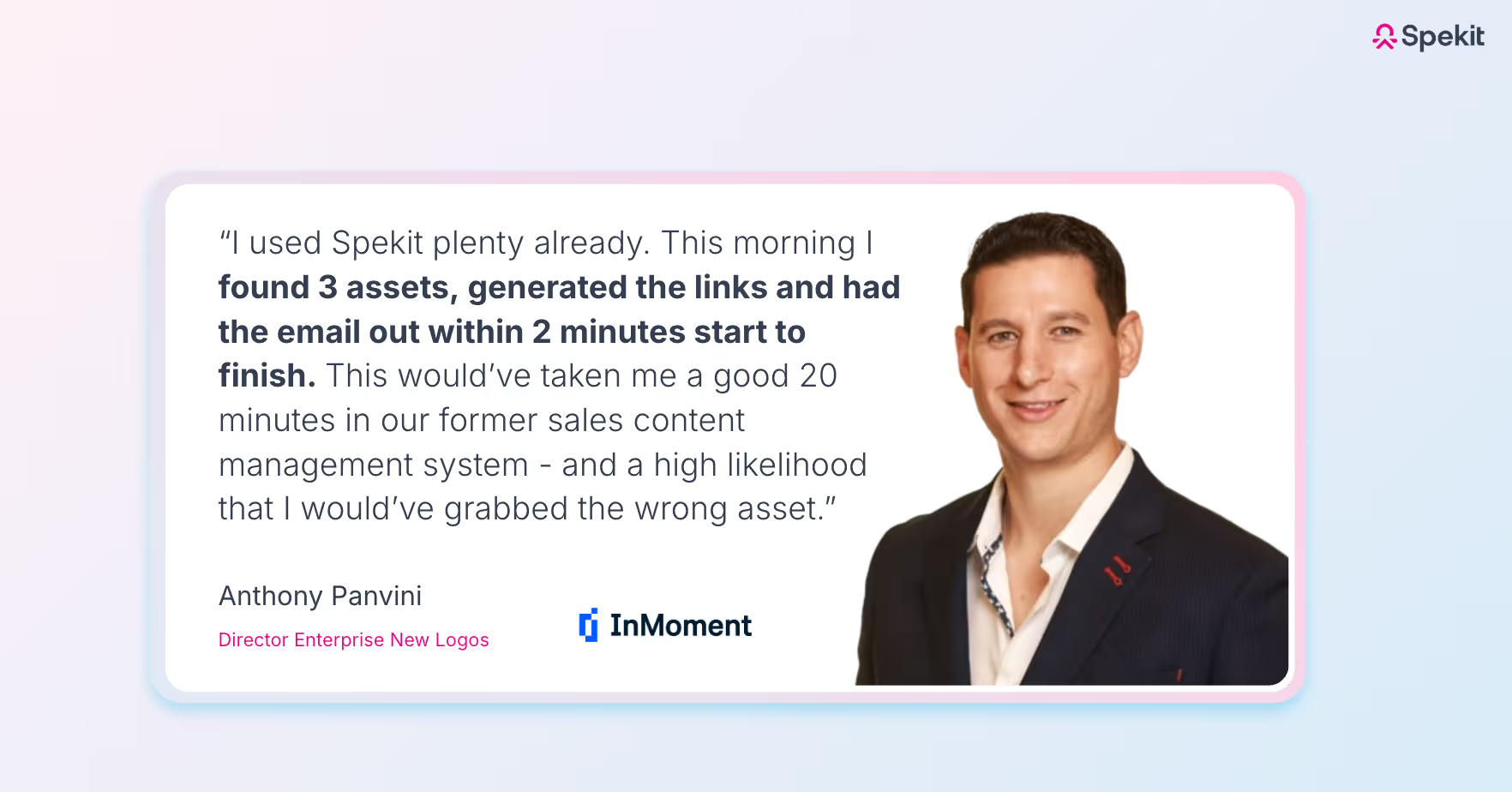
Final thought: You canŌĆÖt out-enable chaos
Your reps arenŌĆÖt lazy. TheyŌĆÖre overwhelmed.
Your buyers arenŌĆÖt disengaged. TheyŌĆÖre inundated.
Your enablement isnŌĆÖt broken. ItŌĆÖs just outdated.
But you can fix it, with structure, AI, and systems that deliver what reps actually need.
If your launches feel chaotic, reactive, or disconnected from revenue, this isnŌĆÖt just a recap. ItŌĆÖs your roadmap.
ŌĆŹ
Want more?
- Get your free copy of the book, Just-in-Time: The Future of Enablement in a World of AI: ŌĆŹ
- Watch the full webinar replay here: ŌĆŹ
- Ready to see ║┌┴Ž│į╣Ž═° in action? Get a demo





